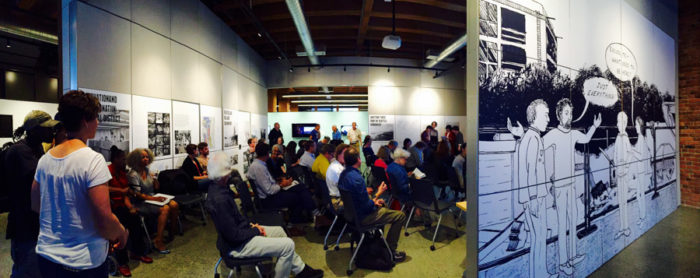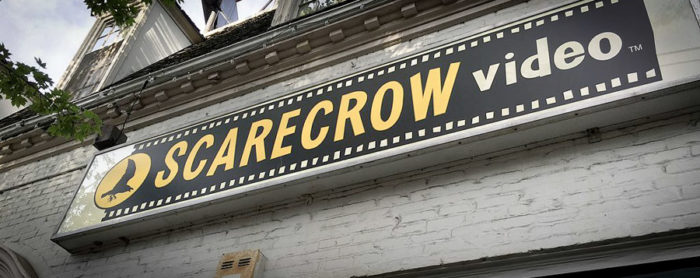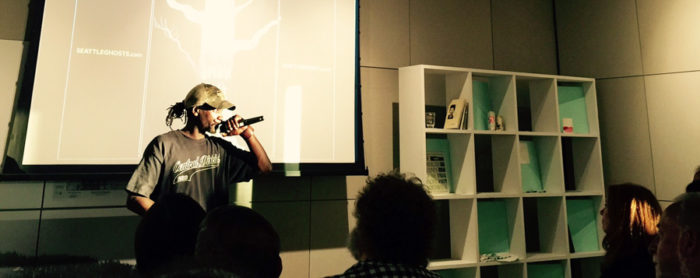
“Where is indispensable?”
Last Thursday, the Residents’ Podium for Seattle Legacy Spaces asked that question, in a forum meant to give Seattleites an opportunity to influence our city’s future.
The event was co-hosted by Councilmember Lisa Herbold and Ghosts of Seattle Past, a mapping project to create a “atlas of our memories,” founded by artist Jaimee Garbacik.
Garbacik opened the conversation saying she hoped that developers and other building professionals in the audience would gain important insight into what shapes people’s shared cultural experiences. She explained that making art about residents’ memories is an opportunity to push back on Seattle becoming a “homogenous, ultimately boring place to be”.
Speakers provided touching, poignant and fascinating answers, identifying specific places as well as types of spaces they felt must be preserved:
The Duwamish legacy:
Ken Workman, Great-great-great-great grandson of Chief Seattle and member of Duwamish Tribal Council pointed to the exposed beams in the Center for Architecture and Design and said, “[The Duwamish] are not done, [we’re] still here, we’re in the trees, we’re in the buildings.”
He said that its fine for developers to build big tall buildings, but emphasized the importance of keeping greenbelts.
Scarecrow Video:
The Roosevelt video store turned film preservation nonprofit was identified as an important legacy space both by Councilmember Herbold and Philip Wohlstetter, artist, author, of Invisible Seattle.
Wohlstetter asked the audience to ponder, “How does a private business become a defacto public space?”
He told the story of the film director Quentin Tarantino setting out on foot from downtown on a pilgrimage to Scarecrow Video. Wohlstetter pleaded the case that Seattle would not be the same without this one-of-a-kind film archive; a cultural, international, local, and anthropological treasure trove.

William Grose home:
The historic home of William Grose, the city’s second black resident, in Madison Valley, was mentioned by Stephanie Johnson-Toliver, a docent at the Northwest African American Museum and committee member for the Central Area Arts and Cultural District. Arriving in Seattle in the 1860s, Grose was a wealthy man, a restaurateur, and a co-founder of the AME Church in Seattle. He is particularly notable for re-selling parcels of land to other black families as they arrived in Seattle.
Reciprocal Recording:
Clark Humphrey, author of the Vanishing Seattle series, traced the complex history of a small triangle-shaped building. Made famous as the home of Reciprocal Recording, the building at 4230 Leary Way NW has played a role in decades of Seattle musicians’ lives. It’s a regular stop on the Nirvana nostalgia DIY tour and definitely “possesses the hearts” of many Death Cab for Cutie fans.
Affordable housing in Chinatown-International District:
Yin Yu, community organizer with Women of Color Speak Out, gave me chills when she described the legacy of Seattle with a backdrop of images from the 1999 WTO protests and I-5 being blocked by an anti-Vietnam War protesters.
Without using the phrase, “suburbanization of poverty,” she illustrated the impact by describing her 90-minute bus trip to Chinatown-International District to connect with her community. It was powerful to hear her testimony about “institutional barriers to creating space” and “10 years of permits already been issued” in a room full of 50 people, many of whom are the people holding those permits.
Small business-friendly commercial spaces:
Ethan Phelps-Goodman, artist, Seattle In Progress offered up one solution for the challenges facing small businesses: Currently, developers are building big commercial spaces that typically only national retailers can fill. Small spaces mean cheaper rent. Phelps-Goodman suggested the council examine policies that encourage developers to include smaller, narrower spaces in new construction that mirror the spaces typically occupied by beloved small businesses.
Performance spaces:

Two musicians from different generations used vivid storytelling to get to the heart of what losing legacy spaces mean to artists. Suntonio Bandanaz, community organizer with 206 Zulu described buildings, and his community, “being made invisible.” He cautioned the audience of building professionals that it is impossible to separate the artists and art from where it came from.
Dave Holden, singer/songwriter, and son of Seattle jazz icon Oscar Holden, asked himself to think of spaces that need preservation. You could feel the sadness, heavy and alive in the room when, after a long pause he said, “there’s nothing left… they’ve torn it down.”
Community gathering spaces:
Whether it was the YMCA in the Central District or a particular historic gay bar, speakers wanted the audience to understand the cultural significance of a space where communities could safely or legally gather. This legacy — the story of the people that occupied those spaces — is what Ghosts of Seattle Past hopes to honor.
Other buildings and spaces mentioned included Washington Hall, Youngstown Cultural Arts Center, the Daybreak Star Cultural Center, KEXP/ KCMU studios, public water fountains, and too many others to mention.
It was clear from the Resident’s Podium that a building is an entry point to tell stories that connect past and present. Events like this may foster dialogue that will allow people to create shared visions of the future.
Councilmember Herbold announced that she hopes Seattle will form a legacy building registry, something that exists in San Francisco, as an enhancement of Seattle’s Office of Economic Development. Through the official designation, a “legacy building” in Seattle might honor and nurture places where Seattleites found and fought for community.
Check out the BOOM! exhibit at the The Center for Architecture and Design (1010 Western Ave, Seattle, WA 98104) The center is Free and open Tuesdays through Fridays from 10 a.m. to 6 p.m., Saturdays 1 p.m. to 5 p.m. BOOM! is up through August 27th.
Complete audio and photographs of the Residents’ Podium will be available on Ghosts of Seattle Past’s website.


8) Georgetown.